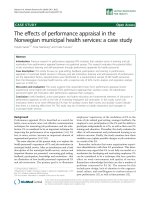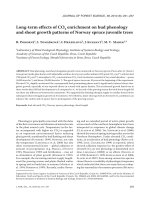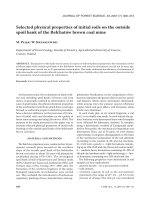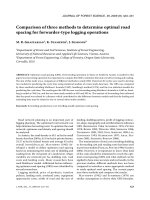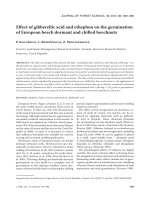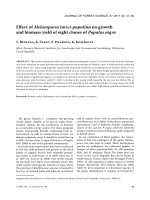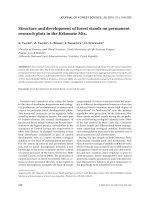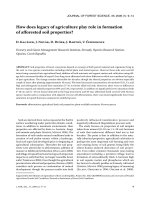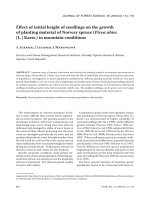Báo cáo lâm nghiệp: "How do lepidopteran seasonal guilds differ on some oaks (Quercus spp.) – A case study" pdf
Bạn đang xem bản rút gọn của tài liệu. Xem và tải ngay bản đầy đủ của tài liệu tại đây (443.2 KB, 13 trang )
578 J. FOR. SCI., 55, 2009 (12): 578–590
JOURNAL OF FOREST SCIENCE, 55, 2009 (12): 578–590
Oaks (Quercus spp.) are represented in Slovakia
(Central Europe) by eight native and one introduced
species; they are distributed in the warmest part
of the country from an altitude of about 100 m up
to 1,000 m a.s.l. More than 250 lepidopteran spe-
cies have been recorded feeding on Quercus spp.
(P 1980; P et al. 1999).
e life history traits of Lepidoptera in Central
Europe and basic information about the species
habitat preferences are relatively well known. Habitat
preferences and community structure of Lepidoptera
in Slovakia were studied earlier by P (1980)
and P et al. (1962, 1999) and S et al.
(1985), but their assessment relied mainly on direct
observations and qualitative characteristics rather
than on quantitative statistical analyses. Habitat
preference was simplified and expressed by “forest
types” (units of forest taxonomy) – areas where the
ecological optima of these species were found. ese
studies showed habitat preferences of the most abun-
dant defoliators: Lymantria dispar, Operophtera
brumata, Erannis defoliaria, Tortrix viridana, Aleim-
ma loeflingiana, Archips xylosteana and several
others. e occurrence of outbreaks was used as an
indicator of habitat preference (the outbreak is de-
fined as an increase in abundance to an extent where
feeding causes visible defoliation, usually heavier
than 30–40%). e role of other species as elements
in forest ecosystems, the relationships among spe-
cies, and their formation into guilds on various oak
species have remained speculative.
P (1954) divided the lepidopteran species
on oaks in Slovakia into four seasonal guilds. e
first was from budburst till the beginning/middle
of June. It is estimated that 80–90% of the total
number of caterpillar species recorded on oaks is
present at that time. e caterpillars in this guild
overwinter as larvae or eggs or hatch from those laid
in early spring. e second guild mainly consists of
leaf miners (Stigmella spp., Phyllonorycter spp. and
How do lepidopteran seasonal guilds differ on some oaks
(Quercus spp.) – A case study
M. T
1
, J. P
1†
, M. K
2
1
Faculty of Forestry and Wood Sciences, Czech University of Life Sciences in Prague, Prague,
Czech Republic
2
Department of Zoology, Comenius University, Mlynská dolina, Bratislava, Slovakia
ABSTRACT: e differences between oak lepidopteran communities were studied in Slovakia in 1993 and 1994.
Sampling was undertaken between April and October on 3 oak species (Quercus robur, Q. petraea, Q. rubra). Biologi-
cal traits of larvae were examined in order to explain differences in seasonal guilds among oaks. Communities varied
in structure and abundance. Species richness in four seasonal guilds (flush, late spring, summer and autumn feeders)
had a similar pattern on each of the studied oak species. e guild of flush feeders had the richest species assemblage,
followed by the late spring feeder guild and both guilds were significantly richer than the summer feeder guild and
autumn feeder guild.
Keywords: lepidopteran larvae communities; Slovakia; oaks; seasonal guilds
Supported by the Ministry of Agriculture of the Czech Republic, Project No. QH 71094 e Use of Dendrochronology in the
Reconstruction of Fluctuation Cycles of Nun and Gypsy Moths in Central Europe.
J. FOR. SCI., 55, 2009 (12): 578–590 579
Tischeria spp. and also some smaller free feeders like
Cyclophora spp.). Some larger species from the first
guild like L. dispar, Orthosia spp. or Biston stratarius
often complete their development at this time. e
third guild occurs in August–September. It consists
partially of the second generation of the first guild
for example Pandemis spp., Cyclophora spp. and
Pseudoips prasinanus. Finally, the fourth guild (Oc-
tober–November) consists of the second flight pe-
riod of leaf miners in the genera Stigmella, Tischeria
and Phyllonorycter and the mostly univoltine genus
Ectoedemia. Recent studies of K et al. (1997)
and K and D (1999) showed that species
diversity and evenness differed significantly between
oak species and time of the year.
Our effort was focused on understanding the
mechanisms that explain variance in lepidopteran
communities in various seasonal guilds on different
oaks. e main study goals were:
(1) To investigate patterns of lepidopteran commu
-
nities on three oak species across a year;
(2) To analyze the similarity of seasonal guilds at
various sites represented by different oaks.
STUDY SITES AND METHODS
A dataset was collected during May to Octo-
ber in 1993 and 1994. Samples were taken every
20 days (nine times per season, the last sampling
was excluded from statistical assessment due to
the zero number of larvae in almost all samples)
using a beating tray (25 beatings per sample). ere
were nine sample intervals each year. Sampling
started on 30 April, 7–10 days after budburst, and
finished on 7 October in both years. Branches at
eye height, about 1 m in length, were beaten dur-
ing each sampling period. Approximately 99.5% of
1,518 collected larvae were identified in situ to the
species level; others were identified after rearing in
a laboratory to the adult stage. G (1952)
and P (1954, 1980) were used as identifica-
tion references. A systematic list of species includ-
Table 1. Number of species, number of specimens and seasonal diversity and evenness of Lepidoptera collected at four
sites in 1993 and 1994
Site/host tree
Site 4
(Q. rubra)
Site 1
(Q. petraea)
Site 2
(Q. robur 1)
Site 3
(Q. robur 2)
Year of study 1993 1994 1993 1994 1993 1994 1993 1994
Number of species 15 25 29 43 46 57 56 67
Number of specimens 23 44 87 139 216 372 264 347
Maximum seasonal diversity
(Shannon-Weaver index)
1.9 2.4 1.7 2.2 2.2 2.7 2.6 2.9
Maximum seasonal evenness
(Pielou’s index)
1.00 1.00 0.96 0.97 0.97 0.98 0.97 0.98
Fig. 1. Location of the forest
complex and individual study
sites
km
Miles
580 J. FOR. SCI., 55, 2009 (12): 578–590
ing selected life history traits can be found in the
Appendix (Table 1A).
e study area in Western Slovakia was between
48°25' and 48°30'N and 17°09' and 17°11'E (Fig. 1).
Four sites were selected representing two stands of
Q. robur, one stand of Q. petraea and one of Q. rubra,
all plots were in the same vicinity. e maximum
distance between any two sites was about 2 km.
Site 1 (Q. petraea): A 25 years old artificially
planted stand of Q. petraea. Planted in dense rows
and surrounded by Scotch pine (Pinus sylvestris).
Sparse understorey. Site elevation about 160 m. e
site represents the plant association Querco-Pinetum
Kripel 1965.
Site 2 (Q. robur 1): A natural close growing
hardwood plain forest with the dominant species
Q. robur.
e site was located in the vicinity of the
Moravia River. e age of trees was estimated to
be about 100 years. Site elevation 150 m. e stand
represents the plant association Fraxino-Ulmetum-
Quercetosum Somsak 1959.
Site 3 (Q. robur 2): Similar to the previous site and
forming a fringe of Q. robur stands along a culti-
vated area. e age of the trees was estimated to be
120 years. Site elevation 160 m. e site represents
the plant association Frangulo-alni-Quercetum
Michalko 1989. Both Q. robur stands had rich un-
derstorey vegetation.
Site 4 (Q. rubra): e introduced Q. rubra is plant-
ed among stands of Scotch pine. e site represents
the plant association Querco-Pinetum Kripel 1965.
Leaf-mining Lepidoptera were excluded from this
study as only free-living species sensitive to sampling
using a beating tray were collected.
In statistical analyses we summarized the number
of individuals in each family to determine if there
were any visual differences in the host preference.
We also calculated diversity (Shannon-Weaver in-
dex) and evenness (Pielou’s index) of Lepidoptera
larvae on each site. en we separated species into
four seasonal guilds and tested the differences in the
number of species and individuals in guilds. is
was done separately for each oak to compare if the
pattern was similar. To test differences, matrixes of
presence/absence (species) or abundance (individu-
als) were constructed. e sum from two samplings
entered the analysis for each guild. All species in
each guild were entered into the matrix separately,
where the rows were species and the columns indi-
cated the presence/absence of species or number
of individuals. Data were transformed as log (x + 1)
prior to analysis. ANOVA was performed to evaluate
differences among seasonal guilds. is was done
separately for each tree species.
e species were divided into seasonal guilds by
determining when they were most abundant. Poly-
voltine species were sorted into seasonal groups
based on the time when the most abundant genera-
tion was found. For example a bivoltine species was
treated as a summer feeder if its individuals were
found only in the summer generation during our
study. Seasonal guilds were usually well defined.
Only in the case of late spring feeders (LSF) there
were two subgroups:
(a) Flush feeders (FlF) that continued feeding in
June;
(b) species that started feeding in June.
e former subgroup was included in the group
of late spring feeders because they feed mainly on
developed and mature leaves.
e classification of the species was as follows:
FlF – species present as larvae that overwintered or
just hatched. ese species were in synchrony with
budburst and were feeding almost exclusively on
new foliage from the end of April to the end of May
and the beginning of June; LSF – species feeding
mainly on developed and recently matured foliage
(usually the end of May up to the end of June and
the beginning of July); summer feeders (SF) – feed-
ing on mature leaves at the beginning of July to the
beginning of August; and autumn feeders (AF) – this
group hatched in the second half of August and the
beginning of September and was feeding on the
toughest leaves.
RESULTS
The number of species and individuals varied
considerably between sites and years. Quercus rubra
had the lowest number of species and individual
specimens followed by Q. petraea with the richest
communities being found on Q. robur (Table 1). e
total number of larvae on Q. rubra was 23 in 1993
vs. 44 in 1994, on Q. petraea 87 in 1993 vs. 139 in
1994 and on Q. robur 216 and 372 in 1993 and 372
and 347 in 1994. On Q. rubra and Q. robur the maxi-
mum species diversity was found in spring and on
Q. petraea in early spring or late spring, respectively.
e evenness was quite stable at all sites.
A comparison of larval abundance classified into
families showed the absence (Psychidae, Tineidae,
Bucculatricidae, Gracillaridae, Ypsolophidae, Oeco-
phoridae) or scarcity (Coleophoridae) of smaller
species on Q. rubra and low numbers on Q. petraea
in both years (Figs. 2a,b). e Geometridae were
the most abundant family in both years of study,
followed by Lymantriidae in 1993 and Noctuidae in
1994. Only species of the families Coleophoridae,
J. FOR. SCI., 55, 2009 (12): 578–590 581
0.1
1
10
100
Psychidae
Tineidae
Bucculatricidae
Gracillaridae
Ypsolophidae
Oecophoridae
Coleophoridae
Gelechiidae
Tortricidae
Pyralidae
Limacodidae
Lycaenidae
Drepanidae
Geometridae
Lasiocampidae
Notodontidae
Lymantriidae
Noctuidae
Number of individuals
Q. petrea Q. robur 1 Q. robur 2 Q. rubra
0.1
1
10
100
1000
Psychidae
Tineidae
Bucculatricidae
Gracillaridae
Ypsolophidae
Oecophoridae
Coleophoridae
Gelechiidae
Tortricidae
Pyralidae
Limacodidae
Lycaenidae
Drepanidae
Geometridae
Lasiocampidae
Notodontidae
Lymantriidae
Noctuidae
Number of individuals
Q. petrea Q. robur 1 Q. robur 2 Q. rubra
0.1
1
10
100
Psychidae
Tineidae
Bucculatricidae
Gracillaridae
Ypsolophidae
Oecophoridae
Coleophoridae
Gelechiidae
Tortricidae
Pyralidae
Limacodidae
Lycaenidae
Drepanidae
Geometridae
Lasiocampidae
Notodontidae
Lymantriidae
Noctuidae
Number of individuals
Q. petrea Q. robur 1 Q. robur 2 Q. rubra
Fig. 2. Comparison of larval abundance per family at 4 sites in 1993 (a) and in 1994 (b)
Gelechiidae, Tortricidae, Lycaenidae, Geometridae,
Lymantriidae and Noctuidae were found on Q. rubra
during this study. Lycaenidae, Geometridae, Noto-
dontidae, Lymantriidae and Noctuidae represent
larger Lepidoptera (pupa 10 to 30 mm in length)
which are generally widely polyphagous (P,
T 2005).
Coleophoridae, Gelechiidae and Tortricidae
represent small Lepidoptera which are much more
sensitive to food quality and foliage architecture
because of their size and feeding strategies. Indi-
viduals from these families were generally absent on
Q. rubra
(only Teleoides paripunctellus and Pande-
mis corylana were found in 1993). T. paripunctellus
spins two leaves together and feeds on the internal
epidermis + mesophyll, the external epidermis
remains untouched. P. corylana spins together
several leaves and is more abundant on Q. robur,
which has leaves arranged in clusters. In 1994,
single individuals of Coleophora ibipennella and
C. lutipennella were found on Q. rubra but they
were more abundant on other oak species. Several
polyphagous tortricid species were also found on
Q. rubra that year.
No. of individualsNo. of individuals
(b)
(a)
Q. petraea Q. robur 1 Q. robur 2 Q. rubra
Psychidae
Tineidae
Bucculatricidae
Gracillaridae
Ypsolophidae
Oecophoridae
Coleophoridae
Gelechiidae
Tortricidae
Pyralidae
Limacodidae
Lycaenidae
Drepanidae
Geometridae
Lasiocampidae
Notodontidae
Lymantriidae
Noctuidae
Psychidae
Tineidae
Bucculatricidae
Gracillaridae
Ypsolophidae
Oecophoridae
Coleophoridae
Gelechiidae
Tortricidae
Pyralidae
Limacodidae
Lycaenidae
Drepanidae
Geometridae
Lasiocampidae
Notodontidae
Lymantriidae
Noctuidae
Q. petraea Q. robur 1 Q. robur 2 Q. rubra
1,000
582 J. FOR. SCI., 55, 2009 (12): 578–590
Table 1A. A systematic list of the species recorded during this study with a short description of life-history traits (the system according to L l998)
Taxon Host specificity Ballooning Feeding strategy Voltinism
Pupa length
(mm)
Psychidae
Canephora hirsuta (PODA, 1761) polyphagous no sac/case bearing univoltine 14–17
Dahlica sp. mosses, lichens, algae no sac/case bearing univoltine 4–6
Proutia betulina (ZELLER, 1839) mosses, lichens and algae no sac/case bearing polyvoltine 6–7
Psyche casta (PALLAS, 1767) polyphagous no sac/case bearing univoltine 5–6
Tineidae
Tineidae sp. organic material no galleries uni- to polyvoltine 6–10
Bucculatricidae
Bucculatrix ulmella ZELLER, 1848
Quercus spp., Castanea sativa, Fagus
sylvatica
no miner only at early stages bivoltine 3–4
Gracillariidae
Gracillariidae sp. Quercus spp. no miner, later conical spun leaf bivoltine 5–6
Ypsolophidae
Ypsolopha alpella (DENIS & SCHIFFERMUELLER, 1775) Quercus spp., mainly Q. pubescens group no free living univoltine 6–7
Ypsolopha ustella (CLERCK, 1759) Fagaceae, Quercus spp. no free living univoltine 7–8
Oecophoridae
Carcina quercana (FABRICIUS, 1775) Quercus spp., Fagus sylvatica no spun leafs univoltine 7–9
Chimabacchidae
Diurnea fagella (DENIS & SCHIFFERMUELLER, 1775) broadleaf woody plants, polyphagous no spun leafs univoltine 10–14
Diurnea lipsiella (DENIS & SCHIFFERMUELLER, 1775) broadleaf woody plants, polyphagous no spun leafs univoltine 9–12
Coleophoridae
Coleophora ibipennella ZELLER, 1849 Quercus spp. no
miner from sac at early stages
only
univoltine 7–9
Coleophora kuehnella (GOEZE, 1783) Quercus spp. no
miner from sac at early stages
only
univoltine 7–9
J. FOR. SCI., 55, 2009 (12): 578–590 583
Taxon Host specificity Ballooning Feeding strategy Voltinism
Pupa length
(mm)
Coleophora lutipennella (ZELLER, 1838) Quercus spp. no miner from sac univoltine 7–9
Gelechiidae
Teleiodes paripunctellus (THUNBERG, 1794) Quercus spp., Betula spp. no spun leaves, skeletonize univoltine 4–6
Teleiodes luculellus (HÜBNER, 1813) Quercus spp. no spun leaves, skeletonize univoltine 4–5
Teleiodes decorellus (HAWORTH, 1812) Quercus spp. no spun leaves, skeletonize univoltine 4–6
Limacodidae
Apoda limacodes (HUFNAGEL, 1766) Quercus spp., Fagus sylvatica no free living, young skeletonize
occasionally
bivoltine
8–9
Tortricidae
Tortrix viridana LINNAEUS, 1758
Quercus spp., Q. robur and Q. pubescens
mainly
no spun leaves, fold leaf margin univoltine 8–12
Aleimma loeflingiana (LINNAEUS, 1758)
Quercus spp., Q. petraea and Q. pubescens
mainly
no spun leaves univoltine 7–9
Acleris ferrugana (DENIS & SCHIFFERMUELLER, 1775)
Quercus spp., Carpinus betulus and other
broadleaf woody species
no spun leaves, skeletonize as young univoltine 7–8
Tortricodes alternellus (DENIS & SCHIFFERMUELLER, 1775) broadleaf trees, Quercus spp. mainly no spun leaves univoltine 9–10
Exapate congelatella (CLERCK, 1759) polyphagous on broadleaf trees no spun leaves univoltine 8–10
Eulia ministrana (LINNAEUS, 1758) polyphagous on broadleaf woody plants no spun leaves univoltine 12
Ptycholoma lecheanum (LINNAEUS, 1758) polyphagous on broadleaf woody plants no spun leaves univoltine 10–13
Archips xylosteana (DENIS & SCHIFFERMUELLER, 1775)
polyphagous on broadleaf trees,
occasionally coniferous
no transversely rolled leaf univoltine 11–14
Choristoneura hebenstreitela (MÜLLER, 1764) polyphagous on broadleaf trees no spun leaves univoltine 13–17
Pandemis corylana (FABRICIUS, 1794) Fagaceae g. sp., Corylaceae g. sp. etc. no spun leaves mostly bivoltine 11–14
Pandemis cerasana (HÜBNER, 1786)
polyphagous on broadleaf sometimes
coniferous woody plants, often Quercus spp.
no spun apical leaves mostly bivoltine 11–14
Pandemis heparana (DENIS & SCHIFFERMUELLER, 1775) polyphagous on broadleaf woody plants no spun leaves uni- to bivoltine 12–15
Spilonota ocellana (DENIS & SCHIFFERMUELLER, 1775) broadleaf trees and shrubs no buds, spun shoots uni- to bivoltine 7–9
Zeiraphera isertana (FABRICIUS, 1794) Quercus spp. no
spun leaves, sometimes
entomophagous
univoltine 8–9
Table 1A to be continued
584 J. FOR. SCI., 55, 2009 (12): 578–590
Table 1A to be continued
Taxon Host specificity Ballooning Feeding strategy Voltinism
Pupa length
(mm)
Ancylis mitterbacheriana (DENIS & SCHIFFERMUELLER, 1775) Fagaceae, especially Quercus no longitudinally folded leaf mostly bivoltine 6–8
Pammene albuginana (GUENÉE, 1845) Quercus spp. – galls of Cynipidae no internal galleries univoltine 7–9
Pyralidae
Elegia similella (ZINCKEN, 1818) Quercus spp. no web nest mostly univoltine 7–8
Phycita roborella (DENIS & SCHIFFERMUELLER, 1775) Quercus spp. no web nest univoltine 10–12
Conobathra repandana (FABRICIUS, 1798) Quercus spp. no web nest polyvoltine 9–10
Conobathra tumidana (DENIS & SCHIFFERMUELLER, 1775) Quercus, prefers Q. cerris and Q. pubescens no web nest univoltine 8–10
Acrobasis consociella (HÜBNER, 1813) Quercus spp. no web nest univoltine 9–10
Lasiocampidae
Phyllodesma tremulifolia (HÜBNER, 1810) broadleaf woody species, often Quercus spp. no free living univoltine 20–25
Poecilocampa populi (LINNAEUS, 1758) polyphagous on broadleaf trees no free living univoltine 12–16
Lycaenidae
Neozephyrus quercus
(LINNAEUS, 1758) Quercus spp. no free living univoltine 9–10
Drepanidae
Watsonalla binaria (HUFNAGEL, 1767) Quercus spp. no free living univoltine 8–12
Geometridae
Semiothisa alternaria (HÜBNER, 1799) polyphagous on woody species no free living, skeletonize as young uni- or bivoltine 12–16
Plagodis dolabraria (LINNAEUS, 1767) Quercus spp., Fagus sylvatica no free living, skeletonize as young uni- or bivoltine 12–14
Ennomos autumnarius (WERNEBURG, 1859) broadleaf woody species no free living univoltine 22–26
Selenia tetralunaria (HUFNAGEL, 1767) polyphagous no free living, skeletonize as young bivoltine 12–16
Colotois pennaria (LINNAEUS, 1761) polyphagous on broadleaf trees yes free living univoltine 13–17
Apocheima pilosaria (DENIS & SCHIFFERMUELLER, 1775) polyphagous on broadleaf trees yes free living, univoltine 14–17
Biston strataria (HUFNAGEL, 1767) Quercus spp. and other broadleaf trees yes free living univoltine 18–23
Biston betularia (LINNAEUS, 1758)
polyphagous on broadleaf trees, sometimes
herbs
probably no free living, skeletonize as young polyvoltine 18–24
J. FOR. SCI., 55, 2009 (12): 578–590 585
Taxon Host specificity Ballooning Feeding strategy Voltinism
Pupa length
(mm)
Agriopis leucophaearia (DENIS & SCHIFFERMUELLER, 1775)Quercus spp. mainly yes free living univoltine 9–12
Agriopis marginaria (FABRICIUS, 1776) Quercus spp. mainly, also other broadleaf trees yes free living univoltine 10–14
Agriopis aurantiaria (HÜBNER, 1799) polyphagous on broadleaf trees and Larix spp. yes free living univoltine 10–16
Erannis defoliaria (CLERCK, 1759) polyphagous on broadleaf trees yes free living univoltine 12–16
Paradarisa similaria (HUFNAGEL, 1767) broadleaf trees no free living, skeletonize as young univoltine 10–12
Hypomecis roboraria (DENIS & SCHIFFERMUELLER, 1775)
broadleaf woody species, Quercus spp.
mainly
no free living, skeletonize as young uni- or bivoltine 14–24
Hypomecis punctinalis (SCOPOLI, 1763) broadleaf woody species no free living, skeletonize as young uni- or bivoltine 13–18
Ectropis crepuscularia (DENIS & SCHIFFERMUELLER, 1775) polyphagous on herbs and low woody trees no free living, skeletonize as young uni- or bivoltine 11–16
Lomographa temerata (DENIS & SCHIFFERMUELLER, 1775) mainly on Prunus spp. and Padus avium no free living, skeletonize as young mostly univoltine 10–11
Campaea margaritata (LINNAEUS, 1767) broadleaf trees no free living, skeletonize as young polyvoltine 12–15
Alsophila aceraria (DENIS & SCHIFFERMUELLER, 1775)
Quercus spp. mainly, also other broadleaf
trees
yes free living univoltine 8–9
Alsophila aescularia (DENIS & SCHIFFERMUELLER, 1775)
Quercus spp. mainly, also other broadleaf
trees
yes free living univoltine 9–10
Hemithea aestivaria (HÜBNER, 1799) broadleaf woody species no free living, skeletonize as young
occasionally
bivoltine
11–13
Cyclophora linearia (HÜBNER, 1799) Fagus sylvatica, Quercus spp., Vaccinium spp. no free living, skeletonize as young bivoltine 11–14
Chloroclysta miata (LINNAEUS, 1758)
Vaccininum spp., Salicaceae g. sp.,
Betulaceae g. sp., Quercus spp. occasionally
no free living univoltine 12–13
Epirrita dilutata (DENIS & SCHIFFERMUELLER, 1775) broadleaf woody species yes free living univoltine 10–12
Operophtera brumata (LINNAEUS, 1758)
polyphagous on broadleaf trees, sometimes
coniferous and Vaccinium spp.
yes free living or spun leaves univoltine 7–9
Eupithecia dodoneata GUENÉE, 1857 Quercus spp. no free living univoltine 5–7
Notodontidae
Phalera bucephala (LINNAEUS, 1758) polyphagous on broadleaf trees no free living, gregariously mostly univoltine 24–30
Drymonia dodonaea (DENIS & SCHIFFERMUELLER, 1775)
Quercus spp., rarely Fagus sylvatica, Betula
spp.
no free living uni- or bivoltine 14–16
Ptilodon capucina (LINNAEUS, 1758) polyphagous on broadleaf trees no free living uni- or bivoltine 16–18
Table 1A to be continued
586 J. FOR. SCI., 55, 2009 (12): 578–590
Taxon Host specificity Ballooning Feeding strategy Voltinism
Pupa length
(mm)
Spatalia argentina (DENIS & SCHIFFERMUELLER, 1775) Quercus spp. no free living uni- or bivoltine 15–18
Noctuidae
Moma alpium (OSBECK, 1778) Quercus spp. mainly no free living, skeletonize as young univoltine 13–15
Acronicta psi (LINNAEUS, 1758) polyphagous on woody plants no free living uni- or bivoltine 16–18
Amphipyra pyramidea (LINNAEUS, 1758) polyphagous on trees no free living univoltine 16–22
Cosmia trapezina (LINNAEUS, 1758) polyphagous on broadleaf trees no free living univoltine 13–14
Agrochola laevis (HÜBNER, 1803) broadleaf trees, oaks mainly adult larva: herbs no free living univoltine 11–13
Eupsilia transversa (HUFNAGEL, 1766)
polyphagous on broadleaf woody plants,
herbs
no free living univoltine 14–17
Lithophane ornitopus (HUFNAGEL 1766) broadleaf trees, oaks mainly no free living univoltine 14–16
Dichonia convergens (DENIS & SCHIFFERMUELLER, 1775) Quercus spp. no free living univoltine 14–16
Orthosia incerta (HUFNAGEL, 1776) polyphagous on broadleaf woody plants no free living univoltine 15–18
Orthosia cruda (DENIS & SCHIFFERMUELLER, 1775) broadleaf trees, oaks mainly no free living univoltine 10–13
Orthosia miniosa (DENIS & SCHIFFERMUELLER, 1775) Quercus spp. mainly no free living, gregariously univoltine 13–15
Orthosia opima (HÜBNER, 1809) polyphagous no free living univoltine 15–17
Orthosia cerasi (FABRICIUS, 1775) polyphagous on broadleaf woody plants no free living univoltine 13–16
Orthosia munda (DENIS & SCHIFFERMUELLER, 1775) polyphagous on broadleaf trees no free living univoltine 16–19
Pantheidae
Colocasia coryli (LINNAEUS, 1758) broadleaf trees no free living, skeletonize as young uni- or bivoltine 14–15
Lymantriidae
Orgyia recens (HÜBNER, 1819) broadleaf woody species no free living
occasionally
bivoltine
12–16
Orgyia antiqua (LINNAEUS, 1758)
polyphagous on woody plants, Vaccinium
spp., Rosaceae mainly
no free living bi- or trivoltine 9–12
Calliteara pudibunda (LINNAEUS, 1758) broadleaf trees, prefers Fagus sylvatica no free living univoltine 18–25
Euproctis similis (FUESSLY, 1775)
Quercus spp., Ulmus spp., Salix spp.
and Rosaceae
no nests univoltine 10–13
Table 1A to be continued
J. FOR. SCI., 55, 2009 (12): 578–590 587
Differences among seasonal guilds in species
number and abundance were quite uniform for all
oaks. In 1993 the number of FlF was significantly
higher than the number of species in other seasonal
guilds, except for Q. petraea, where differences be-
tween FlF and LSF were not significant (Fig. 3a). In
1994, the FlF guilds had significantly more species
on all oaks (Fig. 3b). is pattern was also similar
for the number of individuals (Figs. 3c,d). e only
exception was an insignificant difference between
FlF and LSF on Q. petraea in 1993 (Fig. 3c).
DISCUSSION
Lepidopteran communities account for a high
proportion of all arthropods in tropical (L,
W 1996) and temperate forests (S-
et al. 2003), understanding the variables that
determine the species diversity and composition
should provide information of high ecological and
economic importance. However, the extent to what
the level of species diversity found on any particular
host tree differs from random expectation remains
unclear. Another unanswered question is why large
differences among Lepidoptera communities are
found on taxonomically closely related host species
growing in the same vicinity.
e lepidopteran community structure may be
influenced by many factors originating from diffe-
rent environmental parameters such as pressure
from natural enemies to differences among individu-
als of the same host tree. H et al. (1997) found
that the budburst phenology of individual oaks was
a dominant factor determining the spatial distribu-
tion of O. brumata and T. viridana. e extent to
what this pattern (differences in lepidopteran com-
munities among crowns of the same host species) is
a result of the random distribution of lepidopteran
individuals has been tested recently (C et al.
2003). Some information is known about the spa-
tial effect on the species distribution in small areas
(< 1 km). Lastly, lepidopteran communities vary
significantly between seasons (S, C
2003; S et al. 2003). S et al.
(2003) also studied how lepidopteran communities
in temperate forests are structured. ey determined
several important mechanisms that play a role in
forming arboreal communities, e.g. seasonal vari-
ation influenced caterpillar communities most sig-
nificantly; the similarity of larval assemblages is not
closely related to phylogenetic relationships among
host trees (they studied three tree genera). Another
message from this study is that the host specificity
of Lepidoptera may be less prevalent than previously
Taxon Host specificity Ballooning Feeding strategy Voltinism
Pupa length
(mm)
Lymantria dispar (LINNAEUS, 1758)
polyphagous on broadleaf trees, Quercus
spp. mainly
yes free living univoltine 18–28
Parocneria detrita (ESPER, 1785) Quercus spp. no free living univoltine 11–13
Nolidae
Nycteola revayana
(SCOPOLI, 1772) Quercus spp. no
sparsely spun leaves, skeletonize
as young
mostly bivoltine 9–11
Pseudoips prasinanus (LINNAEUS, 1758) polyphagous on broadleaf trees no free living, skeletonize as young uni- or bivoltine 13–15
Table 1A to be continued
588 J. FOR. SCI., 55, 2009 (12): 578–590
Fig. 3. Differences in the number of species and individuals in seasonal guilds: (a) comparison of species in 1993; (b) comparison
of species in 1994; (c) comparison of individuals in 1993; and (d) comparison of individuals in 1994. e columns designated by
different letters are significantly different (P < 0.05) among the seasonal guilds on individual oak species (ANOVA, LSD test)
0
5
10
15
20
25
30
Q. petrea Q. robur 1 Q. robur 2 Q. rubra
Number of species
0
10
20
30
40
Q. petrea Q. robur 1 Q. robur 2 Q. rubra
Number of species
0
50
100
150
Q. petrea Q. robur 1 Q. robur 2 Q. rubra
Number of individuals
0
50
100
150
200
250
Q. petrea Q. robur 1 Q. robur 2 Q. rubra
Number of individuals
Flush Feeders Late Spring feeders
Summer feeders Autumn feeders
b
b
b
(b)(a)
(d)
(c)
0
5
10
15
20
25
30
Q. petrea Q. robur 1 Q. robur 2 Q. rubra
Number of species
0
10
20
30
40
Q. petrea Q. robur 1 Q. robur 2 Q. rubra
Number of species
0
50
100
150
Q. petrea Q. robur 1 Q. robur 2 Q. rubra
Number of individuals
0
50
100
150
200
250
Q. petrea Q. robur 1 Q. robur 2 Q. rubra
Number of individuals
Flush Feeders Late Spring feeders
Summer feeders Autumn feeders
b
b
b
0
5
10
15
20
25
30
Q. petrea Q. robur 1 Q. robur 2 Q. rubra
Number of species
0
10
20
30
40
Q. petrea Q. robur 1 Q. robur 2 Q. rubra
Number of species
0
50
100
150
Q. petrea Q. robur 1 Q. robur 2 Q. rubra
Number of individuals
0
50
100
150
200
250
Q. petrea Q. robur 1 Q. robur 2 Q. rubra
Number of individuals
Flush Feeders Late Spring feeders
Summer feeders Autumn feeders
b
b
b
a
a
b
b
a
c
b
b,c
b
a
c
c
a
b
b
b
c
a
b
c
b
a
c
c
c
c
a
b
a
b
b
b
c
b
a
b
a
a
b
c
b,c
b,c
c
a
b
a
b
b
b
a
c
b
b,c
c
b
a
a
b
c
c
a
b
b
b
Q. petraea
Q. petraea
Q. petraea
Q. petraea
thought. ey also suggested that resource speciali-
zation may occur at the taxonomic level of the host
genus or family (also suggested by S et al. 1997).
In our study, we focused on the genus Quercus and
found quite large differences in richness and also in
the species composition on oaks.
Results also showed a steady decrease in the
number of species and individuals from early spring
to autumn. is pattern is well known from the
“Quercus type” of host tree (N, H
1982). ese authors suggested that this effect was
due to a decline in available resources. Another
theory was presented e.g. by F (1970), K
and I (1996), who stated that tougher leaves
with a higher concentration of tannin contributed
to the lower richness of Lepidoptera later in the
oak and beech growing season. In addition, a recent
study by F et al. (2004) confirmed a nega-
tive correlation between some specialist oak feeders
and condensed tannins in the canopy of Q. alba and
understorey of Q. velutina. eir results generally
indicated a negative response from both specialists
and generalists to condensed tannins. We have no in-
formation about condensed tannins from our study
sites, but the number of species and individuals was
significantly higher early in spring on almost all the
oak species studied; only Q. petraea was excluded
from this general pattern.
is different pattern on Q. petraea in some sea-
sons may be attributable to budburst which occurred
later than on Q. robur and Q. rubra and resulted in a
low number of early hatching species which by com-
parison were abundant on Q. robur. At the Q. robur
sites there was also a better food supply due to the
presence of other early flushing tree species (Betula
spp., Ulmus spp., Salix spp.). Polyphagous species
may survive on these early flushing species and
later move to Q. robur. Significant differences were
found between LSF and both SF and AF at majority,
but there were no significant differences between
SF and AF. Both SF and AF guilds were of low abun-
dance and species number. While oaks produce the
majority of their leaves in spring, there is also some
production of “May sprouts” (Lammas shoots?) or
leaf regeneration after defoliation events in late May
or early June. is is a source of fresh food in early
summer and is used as a niche by specialized species
(e.g. Minutia lunaris).
CONCLUSIONS
is study documents the types of communities
found on three different oak species. We found
that the number of species in four seasonal guilds
(flush, late spring, summer and autumn feeders)
had a similar pattern on each of the studied oaks:
No. of speciesNo. of individuals
No. of speciesNo. of individuals
spring
feeders
1 2
1 2
1 2
1 2
J. FOR. SCI., 55, 2009 (12): 578–590 589
KULFAN M., ŠEPTÁK L., DEGMA P., 1997. Lepidoptera
larvae communities on oaks in SW Slovakia. Biologia, 52:
247–252.
LAŠTŮVKA
Z. et al., l998. Checklist of Lepidoptera of the
Czech and Slovak Republics. Brno, Konvoj: 117.
LOWMAN M.D., WITTMAN P.K.,
1996. Forest canopies:
methods, hypotheses, and future directions. Annual Review
of Ecology and Systematics, 27: 55–81.
NIEMELÄ P., HAUKIOJA E.,
1982. Seasonal patterns in
species richness of herbivores: Macrolepidoptera larvae
on Finnish deciduous trees. Ecological Entomology, 7:
169–175.
PATOČKA J., 1954. Húsenice na duboch v ČSR. Bratislava,
Štátne pôdohospodárske nakladateľstvo: 262.
PATOČKA J.,
1980. Die Raupen und Puppen der Eichen-
schmetterlinge Mitteleuropas. Monografie Angewandte
Entomologie 23. Hamburg und Berlin, Paul Parey: 188.
PATOČKA J., TURČÁNI M.,
2005. Lepidoptera Pupae of
Central Europe. Stenstrup, Apollo Books.
PATOČKA J., ČAPEK M., CHARVÁT K.,
1962. Contribution
to research of canopy fauna of insects on oaks in Slovakia
with special regard to Lepidoptera. Biologické práce VIII/5.
Bratislava, SAV: 154.
PATOČKA J., KULFAN J., TURČÁNI M.,
1999. Schmetter-
linge (Lepidoptera) als Eichenschädlinge. In: PATOČKA J.,
KRIŠTÍN A., KULFAN J., ZACH P.
(eds), Die Eichenschäd-
linge und ihre Feinde. Zvolen, Institute for Forest Ecology
of SAV: 152–250.
STOLINA M
. et al., 1985. Ochrana lesa. Bratislava, Príroda:
480.
STORK N.E., DIDHAM R.K., ADIS J.,
1997. Canopy arthro-
pod studies for future. In: STORK N.E., ADIS J., DIDHAM
R.K. (eds), Canopy Arthropods. London, Chapman and
Hall: 551–561.
SUMMERVILLE K.S., CRIST T.O.,
2003. Determinants of
lepidopteran community composition and species diversity
in eastern deciduous forests: roles of season, eco-region
and patch size. Oikos, 100: 134–148.
SUMMERVILLE K.S., CRIST T.O., KAHN J.K., GERING J.C.,
2003. Community structure of arboreal caterpillars within
and among four tree species of the eastern deciduous forest.
Ecological Entomology, 28: 747–757.
Received for publication May 13, 2009
Accepted after corrections August 4, 2009
the highest number of species was found among
FlF, a significantly lower number of species among
LSF and both these groups supported a significantly
higher number of species than summer and autumn
feeders with several exceptions. e differences be-
tween SF and AF were found not to be significant.
e same pattern was also found for the number of
individuals. e only exception was an insignificant
difference between FlF and LSF on Q. petraea in
some seasons, insignificant difference between LSF
and AF on Q. robur in some seasons and permanent
insignificant difference between LSF, SF and AF on
Q. rubra.
Acknowledgements
We would like to thank the reviewers who gave
us useful comments and improved the quality of
the manuscript. anks also to Dr. S K,
who gave us valuable comments and recommenda-
tions on early versions of the manuscript and to
A F and Dr. P F, who checked
the English.
R ef er en ces
CRIST T.O., VEECH J.A., SUMMERVILLE K.S., GERING
J.C., 2003. Partitioning species diversity across landscapes
and regions: a hierarchical analysis of alpha, beta, and
gamma diversity. American Naturalist, 162: 734–743.
FEENY P.,
1970. Seasonal changes in oak leaf tannins and
nutrient as a cause of spring feeding by winter moth cater-
pillars. Ecology, 51: 565–581.
FORKNER R.E., MARQUIS R.J., LILL J.T.,
2004. Feeny re-
visited: condensed tannins as anti-herbivore defences in
leaf-chewing herbivore communities of Quercus. Ecological
Entomology, 29: 174–187.
GERASIMOV A.M.,
1952. Nasekomye cheschuekrylye I., 2,
Gusenitsy. Moskva, Leningrad, Izdateľstvo AN SSSR: 339.
HUNTER M.D., VARLEY G.C., GRANDWELL G.R.,
1997.
Estimating the relative roles of top-down and bottom-up
forces on insect herbivore populations: A classic study re-
visited. Proceedings of the National Academy of Sciences,
94: 9176–9181.
KAMATA N., IGARASHI I.,
1996. Seasonal and annual
change of a folivorous insect guild in the Siebolds beech for-
ests associated with the outbreaks of the beech caterpillar,
Quadricalcarifera punctatela (Motschulsky) (Lep., Noto-
dontidae). Journal of Applied Entomology, 120: 213–220.
KULFAN M., DEGMA P.,
1999. Seasonal dynamics of lepido-
pteran larvae communities diversity and equitability on oaks
in the Borská nížina Lowland. Ekológia, 18: 100–105.
590 J. FOR. SCI., 55, 2009 (12): 578–590
Corresponding author:
Prof. Ing. M T, Ph.D., Česká zemědělská univerzita v Praze, Fakulta lesnická a dřevařská,
165 21 Praha 6-Suchdol, Česká republika
tel.: + 420 224 383 738, fax: + 420 234 381 860, e-mail: turcani@fld.czu.cz
Sezonní gildy housenek na některých dubech (Quercus spp.) – Případová
studie
ABSTRAKT: V letech 1993 a 1994 byly na Slovensku studovány rozdíly společenstev motýlů na dubu. Vzorky byly
odebírány ze tří druhů dubů (Quercus robur, Q. petraea, Q. rubra) od dubna do října. Byly zkoumány bionomické
vlastnosti housenek, na jejichž základě byl vysvětlován rozdíl v sezonních společenstvech jednotlivých dubů. Spo
-
lečenstva vykazovala variabilitu ve struktuře i abundanci. Druhová pestrost čtyř společenstev (defoliátoři časného
jara, pozdního jara, léta a podzimu) vykazovala podobný vzor na všech studovaných druzích dubů. Společenstvo
časného jara bylo druhově nejbohatší, následovalo společenstvo pozdních jarních defoliátorů, přičemž obě skupiny
byly statisticky významně bohatší než společenstva letních a podzimních defoliátorů.
Klíčová slova: společenstva motýlích housenek; Slovensko; duby; sezonní gildy
